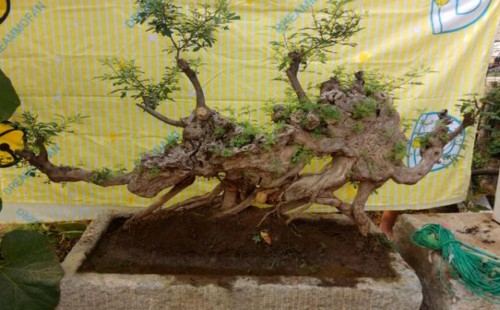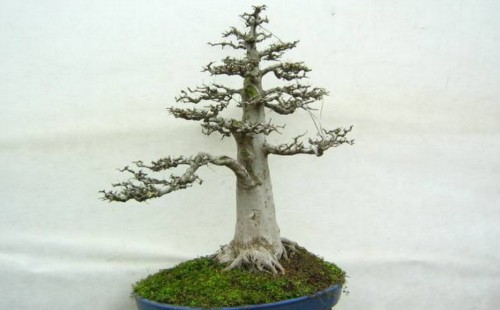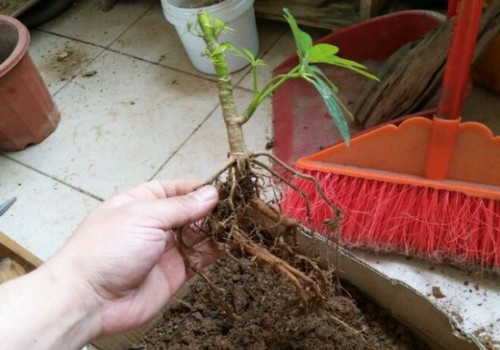The method of making bonsai with bauhinia pimples
Jingdou is an evergreen tree species with the characteristics of sunny but shade-tolerant, warm-loving but cold-resistant, wet-loving but not water-resistant, fertile but barren. Has its shape peculiar, both can view leaves, but also can view the type, so it is a kind of ornamental value of bonsai trees. Moreover, this kind of thorn knot vitality is tenacious and easy to manage, so it is very easy to raise a tree stump bonsai. So, how to make Jinggu bonsai?

Jinggu is a form of old stump of Jingshu, which has unique advantages in making stump bonsai, so it is widely used. However, the production process of Jinggu bonsai also needs to master certain skills, which requires the creator to have a certain foundation for bonsai production, especially the basic techniques of making stump bonsai must be proficient. Let's take a look at the production method of Jinggu bonsai together with Xiaobian below!
I. Materials
To create a Jinggu bonsai, we first need to obtain the appropriate pile scenery. Jinggu Mountain Piles can be dug in the wild, and wild piles generally grow in outdoor forests. Jing pimple with their own tenacious vitality, often able to survive in the harsh environment in the wild, so it is easier to dig. In addition to mountain mining, it can also be artificially cultivated, but the artificial cultivation of old piles takes a long time, and it is often technically demanding to cultivate Jing lumps.
II. Pile digging
After determining the time, we need to dig back the downhill pile in time. However, when digging, pay attention to keeping a certain distance from the stumps of the thorns to avoid cutting off too many roots due to too close distance, thus affecting the survival of the thorns. At the same time, soil lumps should be carried as much as possible in the process of excavation, and protective measures should be taken in the process of transporting down piles to avoid scattering soil lumps, thus affecting their rapid survival.
III. Handling
After digging and transporting the Jinggu piles down the mountain, we cannot blindly put them into the basin. Generally, we still need to raise the piles. Before raising the pile, we also need to properly repair the root, and at the same time use carbendazim or thiophane methyl to sterilize the wound to avoid wound infection, thus affecting the survival of the pile scene. Of course, if there are too many branches, they need to be cut short appropriately to avoid excessive consumption of water and nutrients. After all, before the downhill piles survive, they mainly rely on nutrients and water in the trees to maintain their lives.
IV. Pile maintenance
After the necessary treatment and preliminary modeling of Jinggu downhill pile, the original will be planted in the ground to cultivate embryos. At the same time, the management of light, water and fertilizer should be done well, so as to promote the rapid rooting and sprouting of Jinggu down the mountain pile. After a large number of roots germinate smoothly at the field planting stage and a certain number of branches and leaves are extracted, we will dig them out and transplant them into pots.
V. Upper basin
When the thorns are strong enough and have enough bearing capacity to grow in the flowerpot, we need to choose an appropriate time to plant them in the ornamental pot. Although the root system of Jinggu is relatively shallow, its distribution is still relatively developed, and it prefers a deep and fertile soil environment, so it is necessary to prepare a slightly larger flowerpot and then load it with fertile loose, breathable and slightly acidic basin soil. After finishing the pot, pay attention to taking shade measures in time to avoid a slow seedling survival process. During this period, its roots have not yet recovered their normal absorption capacity, so shading and moisturizing are very important.
VI. Modeling
Before planting, we often need to carry out preliminary modeling treatment on Jingdou, and after planting in pots, we still need to carry out detailed modeling treatment on Jingdou bonsai. Generally, after determining the style of bonsai, we should adopt the combination of climbing and pruning to complete the treatment of pruning modeling, in order to perfect its shape and improve the viewing effect of bonsai. In particular, attention should be paid to the proportion between branches and trees and flowerpots to maintain coordination.
VII. Conservation
Because Jinggu likes fertile and loose basin soil environment, at the same time, it requires sufficient sunshine, warm and humid growth environment, so we usually need to fully receive light in other seasons except for proper shade under the scorching sun in summer. Watering is generally carried out after the pot soil dries, avoiding excessive watering and causing ponding in the pot to cause stuffy roots. In the growing season, we also need to apply some thin liquid fertilizer, mainly nitrogen fertilizer. But at the same time to avoid too much fertilizer, otherwise easy to cause excessive growth of branches and leaves phenomenon. At the same time, it is necessary to do a good job in pest control in due time.
Time: 2019-05-25 Click:
- Prev

The steps of making direct-drying bonsai
The straight dry style is also a common modeling design in the bonsai production process, which requires that the trunk is straight upward, the lower end is thicker and the upper end is thinner, and the lateral branches on both sides of the trunk remain flat, while the root system is often exposed around but appears vigorous and powerful. Viewed from the bonsai as a whole, the lower end branch remains the longest and inclined.
- Next

How to make bonsai with goose palm wood
Goose palm wood, also known as duck foot wood, duck palm wood, because of the strange leaf shape, evergreen branches and leaves, high ornamental value, so many families plant it as a potted plant. But there are also bonsai lovers who turn it into a bonsai masterpiece for appreciation, so how do goose palm wood make bonsai?
Related
- Fuxing push coffee new agricultural production and marketing class: lack of small-scale processing plants
- Jujube rice field leisure farm deep ploughing Yilan for five years to create a space for organic food and play
- Nongyu Farm-A trial of organic papaya for brave women with advanced technology
- Four points for attention in the prevention and control of diseases and insect pests of edible fungi
- How to add nutrient solution to Edible Fungi
- Is there any good way to control edible fungus mites?
- Open Inoculation Technology of Edible Fungi
- Is there any clever way to use fertilizer for edible fungus in winter?
- What agents are used to kill the pathogens of edible fungi in the mushroom shed?
- Rapid drying of Edible Fungi

